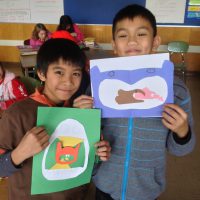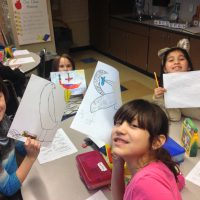If an elementary school teacher has just a half hour to do science each week, he or she may struggle to meet curricular obligations, let alone take kids outside.
That’s where ECO comes in. The nonprofit ECO, which stands for Ecology in Classrooms and Outdoors, visits elementary school classrooms for indoor lessons and nearby outdoor adventures. ECO serves 12 elementary schools and 2,400 students in the greater Portland area, and demand for its programs is growing.
“The teachers really appreciate that we’re coming in with science lessons,” says Bethany Thomas, who co-founded ECO and serves as Development and Outreach Coordinator. “Each of the lessons is tailored to a grade level, so it fits right into their existing curriculum.”
Students love it, too. In fact, many say that ECO is their favorite part of school.
“The kids love being able to explore nature,” Thomas says. “We believe that it helps build an affinity for STEM at an early age.”
With a trained artist on staff, ECO is innovating ways to use art as a gateway to understanding the natural world. In 2014, the Gray Family Foundation funded ECO to develop art-and-ecology lessons for third, fourth and fifth graders. Over the course of the year, ECO trained its instructors to bring the curriculum to 845 students in 30 classrooms.
“Art is a fantastic way to reinforce ecology concepts, and it’s a lot of fun,” Thomas says.
For example, one lesson asks students to draw how a snake or a cat sees a bird (its prey) versus how an insect sees a bird (its predator)—reinforcing concepts about animal adaptations. Another activity inspires students to craft a totem pole representing the food web, starting from the sun at the top and continuing down to plants, herbivores and carnivores.
After a successful pilot year, ECO is excited to take the art activities to other classrooms and help teachers duplicate the lessons.
“They Gray Family Foundation has had a huge impact on our programs and our ability to reach more students and get more students connected to nature, which is our entire mission,” Thomas says.



